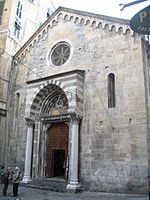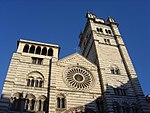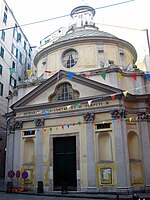The Republic of Genoa was a medieval and early modern maritime republic from the 11th century to 1797 in Liguria on the northwestern Italian coast. During the Late Middle Ages, it was a major commercial power in both the Mediterranean Sea and the Black Sea. Between the 16th and 17th centuries it was one of the major financial centers in Europe.
Throughout its history, the Genoese Republic established numerous colonies throughout the Mediterranean and the Black Sea, including Corsica from 1347 to 1768, Monaco, Southern Crimea from 1266 to 1475 and the islands of Lesbos and Chios from the 14th century to 1462 and 1566 respectively. With the arrival of the early modern period, the Republic had lost many of its colonies, and had to shift its interests and focus on banking. This decision would prove successful for Genoa, which remained as one of the hubs of capitalism, with highly developed banks and trading companies.
Genoa was known as "la Superba" ("the Superb one"), "la Dominante" ("The Dominant one"), "la Dominante dei mari" ("the Dominant of the Seas"), and "la Repubblica dei magnifici" ("the Republic of the Magnificents"). From the 11th century to 1528 it was officially known as the "Compagna Communis Ianuensis" and from 1580 as the "Serenìscima Repùbrica de Zêna" (Most Serene Republic of Genoa).
From 1339 until the state's extinction in 1797 the ruler of the republic was the Doge, originally elected for life, after 1528 was elected for terms of two years. However, in actuality, the Republic was an oligarchy ruled by a small group of merchant families, from whom the doges were selected.
The Genoese navy played a fundamental role in the wealth and power of the Republic over the centuries and its importance was recognized throughout Europe. To this day, its legacy, as a key factor in the triumph of the Genoese Republic, is still recognized and its coat of arms is depicted in the flag of the Italian Navy. In 1284, Genoa fought victoriously against the Republic of Pisa in the battle of Meloria for the dominance over the Tyrrhenian Sea, and it was an eternal rival of Venice for dominance in the Mediterranean Sea.
The republic began when Genoa became a self-governing commune in the 11th century and ended when it was conquered by the French First Republic under Napoleon and replaced with the Ligurian Republic. The Ligurian Republic was annexed by the First French Empire in 1805; its restoration was briefly proclaimed in 1814 following the defeat of Napoleon, but it was ultimately annexed by the Kingdom of Sardinia in 1815.












